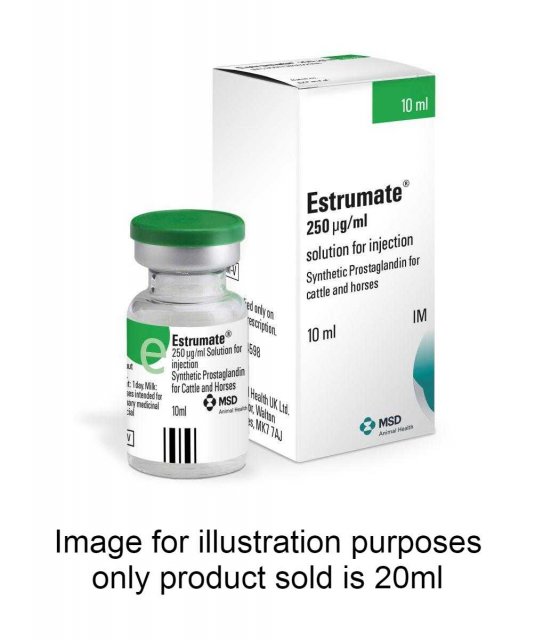Estrumate 20ml
Type: POM-V
PLEASE NOTE: A prescription issued by a UK registered vet (MRCVS) is required before this item can be dispatched.
 In stock
In stock
Product Description
Cloprostenol is a synthetic prostaglandin analogue structurally related to Prostaglandin F2α (PGF2α), for use in cattle and horses. As a potent luteolytic agent it causes functional and morphological regression of the corpus luteum (luteolysis) in cattle and horses followed by return to oestrus and normal ovulation.
Note There is a refractory period of four to five days after ovulation when cattle and horses are insensitive to the luteolytic effect of prostaglandins. Estrumate has a good safety margin and does not impair fertility. No deleterious effects have been reported on the progeny conceived at the oestrus following treatment.
Cattle
- Suboestrus or non-detected oestrus
- Induction of parturition
- Termination of normal pregnancy
- Termination of abnormal pregnancy
- Mummified foetus
- Hydrops of the foetal membranes
- Chronic endometritis (pyometra)
- Ovarian luteal cysts
- Controlled breeding
Horses
- Induction of luteolysis following early foetal death and resorption
- Termination of persistent dioestrus
- Termination of pseudopregnancy
- Treatment of lactation anoestrus
- Establishing oestrous cycles in barren/maiden mares
- As an aid to stud management.
Dosage & Administration
Cattle
(Single or repeated 2ml doses (equivalent to 500 mcg of cloprostenol) by intramuscular injection).
Therapeutic indications
Sub-oestrus (or non detected oestrus)
After diagnosing the presence of a corpus luteum - by rectal palpation - treat with the product and inseminate those animals showing heat. Those animals which do not show heat to be re-examined 11 days later and may receive a second injection and be bred at oestrus or at fixed times; once at 72-84 hours or twice at 72 and 96 hours.
Induction of parturition
Induces parturition in the period around normal term. Induction should take place as close to the predicted calving date as possible and not more than 10 days before. Induction should not be attempted before day 270 of gestation measured from the confirmed day of conception, except in pathological conditions. All treated animals must receive adequate supervision. In common with other methods of shortening the gestation period a higher than usual incidence of retention of the foetal membranes is to be expected.
Termination of normal pregnancy
Normal pregnancy can be terminated in cattle from one week after conception until the 150th day of gestation. Best results are obtained during the first 100 days. Treated animals should be kept under observation until expulsion of the foetus and placenta is complete.
Termination of abnormal pregnancy
- Mummified foetus - induction of luteolysis at any stage of pregnancy will result in the expulsion of the mummified foetus from the uterus into the vagina from which manual removal may be necessary. Normal cyclical activity should then follow.
- Hydrops of the foetal membrane - Pathological accumulation of placental fluids can cause severe physiological complications and death. Surgical drainage is not usually successful in alleviating the condition. In such cases, a single dose may be used to induce parturition.
Chronic endometritis (Pyometra)
Treat with a single dose. In long-standing cases treatment may be repeated after 10-14 days.
Ovarian luteal cysts
Where cystic ovaries associated with persistent luteal tissue and absence of heat are diagnosed, the product has proved to be effective in correcting the condition and bringing about a return to cyclicity.
Other indications: Controlled breeding
Examples of programmes which have been used are:
i) A single treatment of cattle with palpable evidence of a corpus luteum, followed by breeding on detection of the subsequent oestrus.
ii) Detection of oestrus for 6 days, breeding those animals seen in heat; a single treatment is given to all non-served animals on the 6th day and these cattle are bred at subsequent oestrus.
iii) Two injections 11 days apart, breeding at oestrus or at fixed times (see below).
iv) As iii) above, but breeding any animals showing oestrus before the second injection. Thus the second dose is given only to those cattle not seen in oestrus during that time and is followed by breeding either on signs of oestrus or at fixed times (see below).
Cattle which respond to a single prostaglandin injection will normally do so within 6 days of treatment. The response time after two injections is more rapid. Animals may be inseminated on detection of oestrus in any of the breeding programmes. However, fixed time insemination should only be used following the second of a two injection programme (i.e. examples iii) and iv)). In the latter case insemination should be performed either once at 72-84 hours or twice at 72 and 96 hours after the second injection, as preferred.
Double ‘fixed-time’ insemination may give superior results to a single insemination. However, economic factors in the particular herd may outweigh such a benefit.
For successful treatment, animals should be cycling normally. Rectal examination before treatment should avoid the disappointment of treating non-cycling (an-oestrus) or pregnant animals.
Attention should be directed to the diet and condition of the treated animals. Sudden changes in feeding levels, in feed constituents and in housing, etc should be avoided around the time of the breeding programme, as should any other factor, such as regrouping, which could reasonably be expected to lead to stress.
If artificial insemination is to be used, the quality of semen and insemination technique should be assured beforehand.
A recommended guideline for use of the product in dairy cows would be as follows:
After the first injection, inseminate any cows showing signs of heat.
Animals that do not show signs of heat should be injected 11 days after the first injection and then inseminated 72-96 hours later.
Control of the oestrous cycle is of value in:
1) The dairy herd:
a) To control oestrus in the individual animal giving better control of the individual calving index and reducing the number of cows culled as barren.
b) To control oestrus in groups of cows to promote management of the herd in groups of suitable size and facilitate the maintenance of a seasonal calving pattern.
c) To permit the use of artificial insemination (AI) in dairy heifers.
2) The beef herd:
a) To facilitate the use of AI to obtain better progeny by use of high quality bulls.
b) To enable the most effective use of available bulls where natural service is preferred.
c) To permit better herd management at conception and calving.
Horses
(Ponies and donkeys: single dose of 0.5-1.0 ml (equivalent to 125-250 mcg of cloprostenol) by intramuscular injection. Thoroughbreds, hunters and heavy horses: 1-2 ml (equivalent to 250- 500 mcg cloprostenol) by intramuscular injection).
- Induction of luteolysis following early foetal death and resorption: about 8-10% of all mares which conceive lose the conceptus during the first 100 days of pregnancy. Persistence of luteal function in the ovary precludes an early return to oestrus.
- Termination of persistent dioestrus: non-pregnant mares frequently and spontaneously go to and out of periods of prolonged dioestrus. A very high proportion of mares in this category i.e. not cycling, are in prolonged dioestrus rather than anoestrus, particularly in the latter part of the breeding season.
- Termination of pseudopregnancy: some mares which are covered at normal oestrus and subsequently found to be empty (but not having lost or resorbed a conceptus) display clinical signs of pregnancy. These animals are said to be “pseudopregnant”.
- Treatment of lactation anoestrus: failure of lactating mares to cycle again for several months after exhibiting an early ‘foal heat’ can be avoided.
- Establishing oestrous cycles in barren/maiden mares: some of these animals will be found, on examination, to have a functional corpus luteum and are suffering from abnormal persistence of luteal function or are simply failing to exhibit normal oestrous behaviour (“silent heat”) while ovarian cyclicity continues.
- As an aid in stud management: mares may be brought into oestrus on a planned timing schedule (singly or in groups), to facilitate more efficient use and management of stallions during the breeding season.
Withdrawals
Cattle
- Meat: 1 day
- Milk: zero hours
Horses
- Not to be used in horses intended for human consumption.
- Treated horses may never be slaughtered for human consumption.
- The horse must have been declared as not intended for human consumption under national horse passport legislation.
Delivery & Returns
|
|
Standard Non-refrigerated items By 6pm |
Priority Refrigerated items By 12am |
|
£100 + |
£12.00 |
£25.00 |
Delivery to United Kingdom only
Please note there is a small excess of £7.50 for dispatch to Highlands and Islands and Isle of Wight and £12 to Guernsey and Jersey as governed by your postcode.
- We are unable to ship to Northern Ireland. Any orders placed online will be cancelled and refunded.
- Orders are typically dispatched the day after they are received. For example, orders placed on Monday, will be dispatched on Tuesday. Orders received on Friday will not be dispatched until Monday subject to stock availability.
- Orders placed on a Thursday or Friday that have refrigerated items included will be dispatched on Sunday for delivery before 12pm on the following Monday to ensure that the items are delivered to you under controlled conditions.
- We do not offer a Saturday or Sunday delivery service.
- Standard and Priority costs apply to the UK mainland only. Highlands and Islands and Isle of Wight may incur an excess to cover additional carriage costs as governed by your postcode. Full details can be found by clicking the link below.
- Standard Delivery (non-refrigerated products) guarantees delivery by 6pm
- Priority Delivery (refrigerated products) guarantees delivery by 12pm.
- We are unable to dispatch refridgerated products to Highlands and Islands addresses. Full details can be found by clicking the link below.
For full delivery details click here
Faulty Goods Returns
In the unlikely event that you receive faulty or damaged goods please call 01306 628215 within 72 hours of receipt of your goods. Please have your order reference to hand. You will be asked to provide evidence of the damaged goods if damaged in transit.
Restricted Goods Returns
We are unable to offer refunds on the following products.
- Animal medicines - general & vaccines
- Refrigerated/temperature sensitive products
Please contact the Farmacy Team before sending any returns on 01306 628215.
For full returns details click here
Product Species

Cattle - Dairy
Cattle - Beef
Home Delivery
UK mainland delivery from £12.00




Write the first review